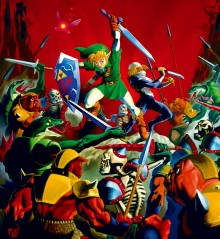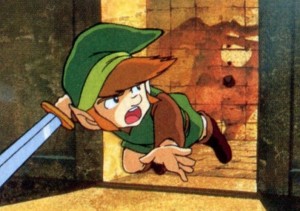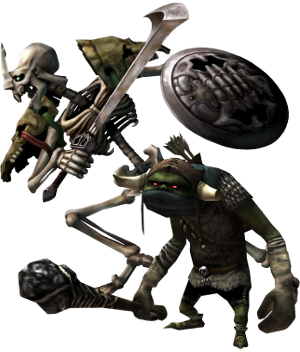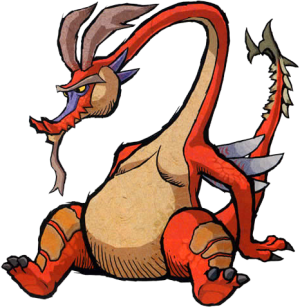The Division Between Tribes and Monsters
Posted on November 23 2012 by Djinn
 The land of Hyrule has always been a very diverse realm with a large variety of peoples and monsters living throughout. A very common aspect of the Zelda series is there being a clear distinction between a friendly NPCs that will talk to Link and cannot be attacked, and unfriendly enemy NPCs, which almost never speak and only exist as opponents to be defeated. This does not account for everyone, as there are the occasional exceptions on both sides. Nonetheless, Nintendo has generally maintained a curious stance on having a strong division between hostile species and ally species. Link is generally never allowed to fight — and certainly not kill — any member of one of the ally species, unless it is a named NPC, just as there are incredibly few friendly or helpful members of what is considered a monster species. This very black and white approach is rare these days in modern gaming and not entirely common in fantasy storytelling. Many fantasy stories will have more shades of gray, with the occasional bandits or evil individuals of the hero’s tribe or country. This is not an unheard of concept, since any of us can find a criminal element within our own communities. On the other hand, the monsters within the Zelda series are only viewed as evil. This lack of any development is sometimes seen as a flaw by fans. But it wasn’t always this way.
The land of Hyrule has always been a very diverse realm with a large variety of peoples and monsters living throughout. A very common aspect of the Zelda series is there being a clear distinction between a friendly NPCs that will talk to Link and cannot be attacked, and unfriendly enemy NPCs, which almost never speak and only exist as opponents to be defeated. This does not account for everyone, as there are the occasional exceptions on both sides. Nonetheless, Nintendo has generally maintained a curious stance on having a strong division between hostile species and ally species. Link is generally never allowed to fight — and certainly not kill — any member of one of the ally species, unless it is a named NPC, just as there are incredibly few friendly or helpful members of what is considered a monster species. This very black and white approach is rare these days in modern gaming and not entirely common in fantasy storytelling. Many fantasy stories will have more shades of gray, with the occasional bandits or evil individuals of the hero’s tribe or country. This is not an unheard of concept, since any of us can find a criminal element within our own communities. On the other hand, the monsters within the Zelda series are only viewed as evil. This lack of any development is sometimes seen as a flaw by fans. But it wasn’t always this way.
In the early days of the series there were no distinct tribes in Hyrule. There were no named races of any kind mentioned as a tribe or included as a part of the story; only the hero who looked much like an elf and the various enemies to fight. The name “Hylian” did not come about until A Link to the Past, which also included a brief history of the people and a few random characteristics. Certain groups of enemies, such as the Moblins or the Goriya, could be assumed to be representative of races that thrived somewhere in the wilderness of Hyrule, but the game manuals did not elaborate on this in any way. The game, however, seemed to imply they were, indeed, full races.
 There were NPCs even in the first game, which were found living within caves spread throughout the land. Most were Hylian merchants, with the occasional old man helping Link out with a few words of wisdom. Interestingly, however, there were a few instances of an enemy creature who would speak to Link and even help him. Hidden underneath certain trees would be a Moblin who would ask that Link not tell anyone and pay him in rupees. There was even a Goriya who did not fight Link but let him pass after being handed some meat. Later on, villages were added, filled with many citizens for Link to speak with and learn skills from, but no friendly monsters remained.
There were NPCs even in the first game, which were found living within caves spread throughout the land. Most were Hylian merchants, with the occasional old man helping Link out with a few words of wisdom. Interestingly, however, there were a few instances of an enemy creature who would speak to Link and even help him. Hidden underneath certain trees would be a Moblin who would ask that Link not tell anyone and pay him in rupees. There was even a Goriya who did not fight Link but let him pass after being handed some meat. Later on, villages were added, filled with many citizens for Link to speak with and learn skills from, but no friendly monsters remained.
Further on in A Link to the Past, the entire landscape was filled with various friendly NPCs of all ages and sizes who would either help Link out or call upon soldiers to stop him. The line of distinction between friendly and enemy NPCs was blurred heavily in this game. Between the thieves of the Lost Woods, the castle guards of Hyrule, and the various inhabitants found within the Dark World, there is hardly a clear distinction between friendly NPC and enemy monster based on race. There friends and foes on both sides, with friendly monsters and enemy Hylians.
 Later on in Ocarina of Time, however, a much greater emphasis was placed on which races were considered consistently friendly and which are monsters who would always be enemies. Normally, intelligent, peaceful tribes were not allowed to be harmed by the player. Even when there’s a combat situation with one, they cannot be killed, only fought until they escape. Link has no ability to attack or harm the friendly NPC tribes such as the Gorons or Zora, and is not allowed to kill a Gerudo guard as he could a common monster when attacked inside their fortress. And besides, their position towards Link changes for the better over the course of the game, and they become hands off as far as combat is concerned. The Skull Kids found within the Lost Woods are similar, only fought until they take enough damage and escape.
Later on in Ocarina of Time, however, a much greater emphasis was placed on which races were considered consistently friendly and which are monsters who would always be enemies. Normally, intelligent, peaceful tribes were not allowed to be harmed by the player. Even when there’s a combat situation with one, they cannot be killed, only fought until they escape. Link has no ability to attack or harm the friendly NPC tribes such as the Gorons or Zora, and is not allowed to kill a Gerudo guard as he could a common monster when attacked inside their fortress. And besides, their position towards Link changes for the better over the course of the game, and they become hands off as far as combat is concerned. The Skull Kids found within the Lost Woods are similar, only fought until they take enough damage and escape.
The Gorons and the new, friendly Zora introduced in Ocarina of Time have always maintained this friendly NPC disposition in each game they have appeared in since. Like with the Gerudo or Skull Kids, any time one is fought, they cannot be killed and they still remain or become your allies. Most new tribes, such as the Rito, Anouki, Kikwi, etc., continue this trend and are always considered the friendly NPCs. The tribes system introduced by Ocarina of Time created a strong division between civilized people and monsters.
However, as stated before, there have always been exceptions to this; there’s always the occasional helpful members from enemy races and opponents from friendly races. This began with the hidden Moblins from the first Legend of Zelda and continued with Zora King of A Link to the Past (all prior Zoras were nothing more than monsters). Then, of course, there are the antagonists Ganondorf and Twinrova from the Gerudo tribe. They are the only Gerudo that Link fights and kills over the course of his adventures. The other Gerudo guards he defeats, but only injures, in an effort to maintain the traditional monster/humanoid duality. While at first the Gerudo tribe existed to give an origin to the antagonist of the series, they were still a civilized tribe of people living within the land and therefore not for Link to fight and kill as he does with the monsters of the game. Vaati of The Minish Cap had a similar origin among the friendly Picori. He served to be the one evil member of an otherwise friendly and peaceful people.
 There have been a couple of instances of tribes that have started out as a common enemy type and either through popularity or necessity they are transformed into a peaceful, civilized tribe in a later sequel. The Zora have appeared as both monster and ally, though not in the same game. The Oracle series has even made a unique distinction between them as separate tribes or races that are either aligned with or against the Hylians. The Zora of Ocarina of Time were labeled the peaceful Sea Zora and the more belligerent Zora of the earlier titles were called River Zora. However, again, even before that there was a single friendly monstrous Zora found in King Zora from A Link to the Past, who sold Link the Flippers, and another found on Koholint Island in Link’s Awakening. The Zora were the first species to make the transition from enemy monster type to a friendly and peaceful tribe of Hyrule, although it was a slow transformation. Only within the Oracle series have both types of Zora appeared within the same game at the same time. In every other game, only the monstrous River Zora or the more humanoid Sea Zora appeared. In this Nintendo still maintains the same distinction between enemy and ally..
There have been a couple of instances of tribes that have started out as a common enemy type and either through popularity or necessity they are transformed into a peaceful, civilized tribe in a later sequel. The Zora have appeared as both monster and ally, though not in the same game. The Oracle series has even made a unique distinction between them as separate tribes or races that are either aligned with or against the Hylians. The Zora of Ocarina of Time were labeled the peaceful Sea Zora and the more belligerent Zora of the earlier titles were called River Zora. However, again, even before that there was a single friendly monstrous Zora found in King Zora from A Link to the Past, who sold Link the Flippers, and another found on Koholint Island in Link’s Awakening. The Zora were the first species to make the transition from enemy monster type to a friendly and peaceful tribe of Hyrule, although it was a slow transformation. Only within the Oracle series have both types of Zora appeared within the same game at the same time. In every other game, only the monstrous River Zora or the more humanoid Sea Zora appeared. In this Nintendo still maintains the same distinction between enemy and ally..
Another creature that started out evil but was later fleshed out into a tribe of their own were the Deku Scrubs. In Ocarina of Time they were an enemy constantly encountered in the forest region. There were occasional Business Scrubs that would trade with Link, and many of the normal Deku Scrubs (barring the Mad Scrubs) would speak to you and run away rather than be killed, but they remained enemies overall; they would only trade with you as an apology for attacking and the ones who ran still only served the villain. Later, in Majora’s Mask, the Scrubs were a tribe with a kingdom and citizens of their own. Within this game the Scrubs were an ally species that Link only fought while infiltrating their castle. Later on in Four Swords Adventures, Link encounters Deku Scrubs who will speak to him as villagers and do not attack. Ironically, they appear to be on Ganondorf’s side and talk of conquering Hyrule, not unlike those of Ocarina of Time, who served Gohma.
 Other interesting possible exceptions are the monsters that could be seen as intelligent races. The Moblins started out as common enemies in the overworld of the original Legend of Zelda and made many more appearances later on in the series. The few hidden nonviolent Moblins within the first game introduced the idea that they could be intelligent and not evil. This wasn’t seen again until the Oracle series, when Link was capable of transforming into a Moblin with the Moblin Ring and speak to a few. There was also a larger NPC named the Great Moblin who acted as their leader, kidnapping maidens and plotting against the Borons. Even in The Wind Waker, a certain one named Mo exchanged letters with a girl named Maggie… although most of his letters to her alluded to him possibly wanting to eat her.
Other interesting possible exceptions are the monsters that could be seen as intelligent races. The Moblins started out as common enemies in the overworld of the original Legend of Zelda and made many more appearances later on in the series. The few hidden nonviolent Moblins within the first game introduced the idea that they could be intelligent and not evil. This wasn’t seen again until the Oracle series, when Link was capable of transforming into a Moblin with the Moblin Ring and speak to a few. There was also a larger NPC named the Great Moblin who acted as their leader, kidnapping maidens and plotting against the Borons. Even in The Wind Waker, a certain one named Mo exchanged letters with a girl named Maggie… although most of his letters to her alluded to him possibly wanting to eat her.
There are several other creatures encountered in the series with names ending in “blin”, including Miniblins, Bokoblins and Bulblins. The Miniblins and Bokoblins do wear an assortment of clothing and armor and often use weapons just as the other intelligent species of Hyrule do. There was even a variant of the Bokoblin called the Technoblin, which carried advanced weapons to use against Link. However, none of them have ever displayed any kind of greater intelligence or have spoken any lines; they’re always just especially clever monsters.
The Bulblins of Twilight Princess, on the other hand, displayed a little bit more intelligence as a tribe, not only wearing clothes like the Moblins that came before them, but also riding animals, firing bows, kidnapping Hylians, and making camps in the desert. King Bulblin speaking to Link near the end of the game came as a surprise to both Link and Midna, who did not believe him to have the capability. However, in all appearances, the Bulblins maintain the evil NPC status and are always adversaries.
Much like the various enemies that contain the “blin” suffix, there are a larger pool of differing creatures found in and around Hyrule that follow a similar naming scheme with “fos”. There are many examples such as Lizalfos, Dinolfos, Aeralfos, and Wolfos. The pattern behind these isn’t as exact as that of the blin family. The Lizalfos, Dinolfos, and Aerialfos are all bipedal anthropomorphic reptiles that wear armor and carry weapons, which signifies that they come from a tribe of intelligent people like the more well-known tribes. However, the inclusion of the animal Wolfos and the undead Stalfos might mean that the term “fos” is used to signify an enemy or dangerous creature and is not used specifically for intelligent humanoids. So far there have not been any peaceful or nonviolent individuals of the “fos” grouping of enemies, which might indicate a level of separation between them and the “blin” family.
 The Dragons encountered in the series are another gray area that can be confusing if considering them as a single species. They can range from the monstrous Gleeok and Volvagia to the friendly Valoo or the three dragons of Skyward Sword. There are a large amount of examples of dragons on both sides of the NPC spectrum, which makes them hard to categorize. The main antagonist of Oracle of Seasons, General Onox (who’s final form is the Dark Dragon), displayed a higher level of intelligence than that of previous evil dragons, who have mostly appeared to be just the same as any other boss monster. Nintendo doesn’t ever seem to make any attempt to sort them into a single grouping or tribe. Comparing them and including the various examples as part of a single species is another activity of the fans, rather than the developers. Perhaps one day Nintendo will elaborate further on the state of the dragons within Hyrule. As it stands right now, their definition is far too vague to determine if they are all in fact parts of a single species or tribe, or isolated cases of similar but unrelated creatures.
The Dragons encountered in the series are another gray area that can be confusing if considering them as a single species. They can range from the monstrous Gleeok and Volvagia to the friendly Valoo or the three dragons of Skyward Sword. There are a large amount of examples of dragons on both sides of the NPC spectrum, which makes them hard to categorize. The main antagonist of Oracle of Seasons, General Onox (who’s final form is the Dark Dragon), displayed a higher level of intelligence than that of previous evil dragons, who have mostly appeared to be just the same as any other boss monster. Nintendo doesn’t ever seem to make any attempt to sort them into a single grouping or tribe. Comparing them and including the various examples as part of a single species is another activity of the fans, rather than the developers. Perhaps one day Nintendo will elaborate further on the state of the dragons within Hyrule. As it stands right now, their definition is far too vague to determine if they are all in fact parts of a single species or tribe, or isolated cases of similar but unrelated creatures.
Overall, the tendency Nintendo has to maintain a strong division between monster and ally — with only a scant few exceptions — is seen as a weakness by some fans, who want a little more realism within the storytelling. Adding in several shades of gray to the characters and races of a story does add an extra layer of depth. Still, Nintendo has kept to a very traditional style with the storytelling of the games throughout all the many sequels and the changes that have been made to the overall story and setting. Adding in such things as evil Hylians for Link to defeat or a village of benevolent Moblins to befriend could be viewed as blasphemy by a lot of longtime fans. Some of these things have come in small doses through the various named and important NPCs that go against the flow and act differently from the rest of their tribe, and as I’ve addressed, it wasn’t always the way it seems to be now. Perhaps in future the developers at Nintendo might move a little further with this trend.



